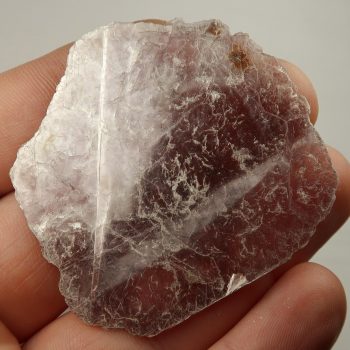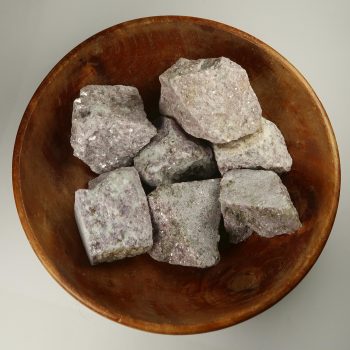Lepidolite
Lepidolite is a type of mica that is typically pink, purple, grey, or lavender in colour.
It is sometimes used as a source of lithium, rubidium, and caesium.
It, like other Micas, consists of very thin plates which can sometimes be partially opened up like the pages of a book.
Showing all 2 results
Appearance
A layered mineral that often looks almost like a series of sheets, foliated. It is often lavender, pink, purple, or pale grey-pink.
Uses and History
Lepidolite is often used as a decorative gemstone in lower end jewellery – Lepidolite and Quartz is often cut en cabochon or into beads.
However, its primary use is as an ore of Lithium, and sometimes produces Rubidium and Cesium as well.
Locales
Some of the most important locales for Lepidolite include Australia, Brazil, Canada, Japan, Madagascar, Russia, Sweden, and the USA.
Mineralogy
Hazards and Warnings
Almost all rocks, minerals (and, frankly, almost all other substances on earth) can produce toxic dust when cutting, which can cause serious respiratory conditions including silicosis.
When cutting or polishing rocks, minerals, shells, etc, all work should be done wet to minimise the dust, and a suitable respirator or extraction system should be used.
Translations
Arabic:
- الليبيدوليت
Hindi:
- लेपिडोलाइट
Portuguese:
- lepidolita
Bengali:
Indonesian:
Punjabi:
- ਲੇਪਿਡੋਲਾਈਟ
English:
Italian:
Russian:
- Лепидолит
- лепидолитовая
French:
- lépidolite
Japanese:
- レピドライト
Spanish:
- Lepidolita
German:
- Lepidolith
Korean:
Thai:
Gujurati:
- લેપિડોલાઇટ
Mandarin and Traditional Chinese:
- 锂云母
- 鋰雲母
Urdu:


